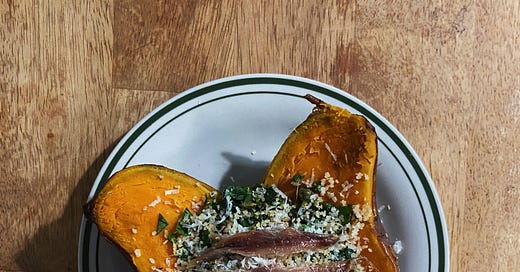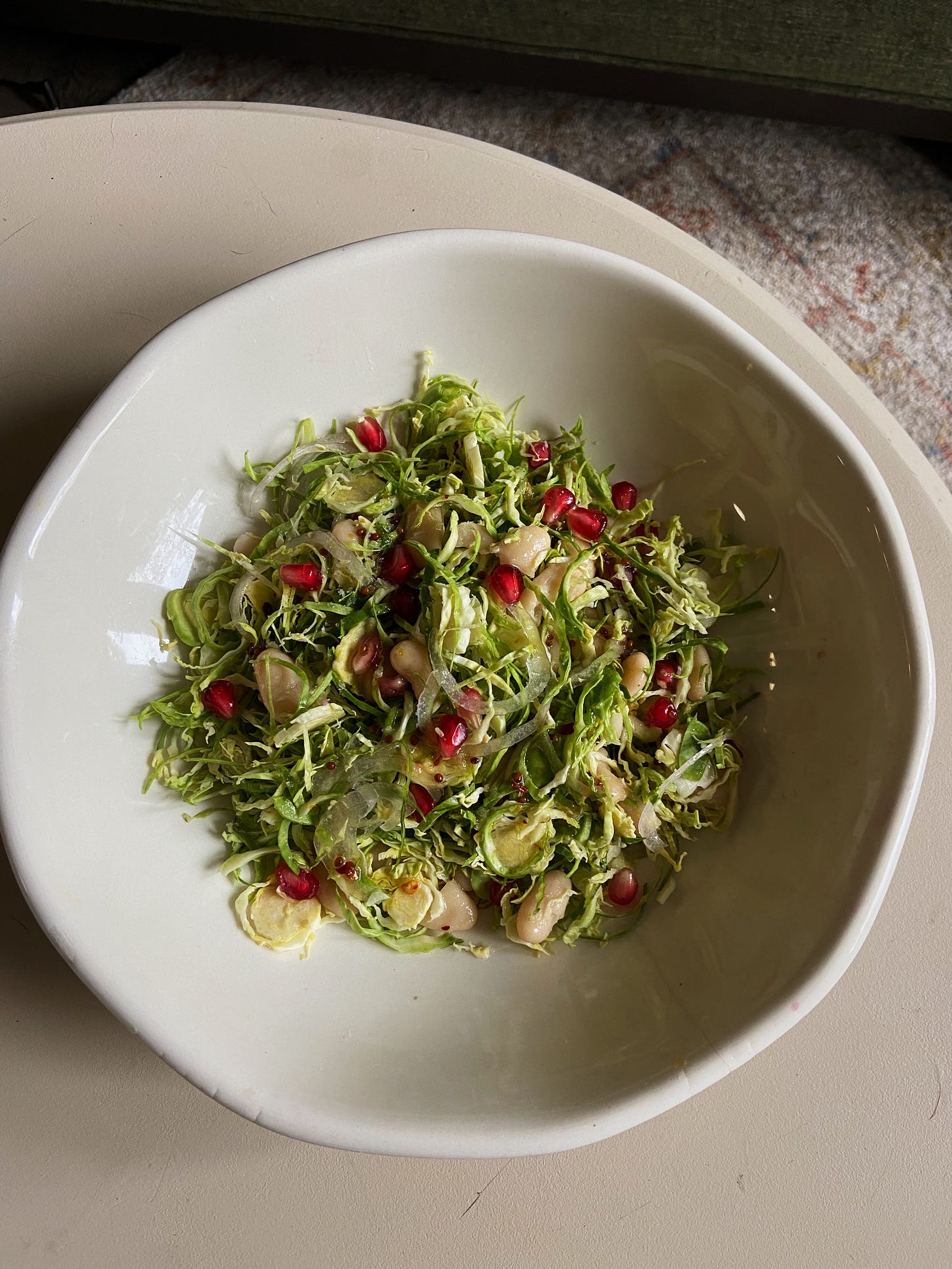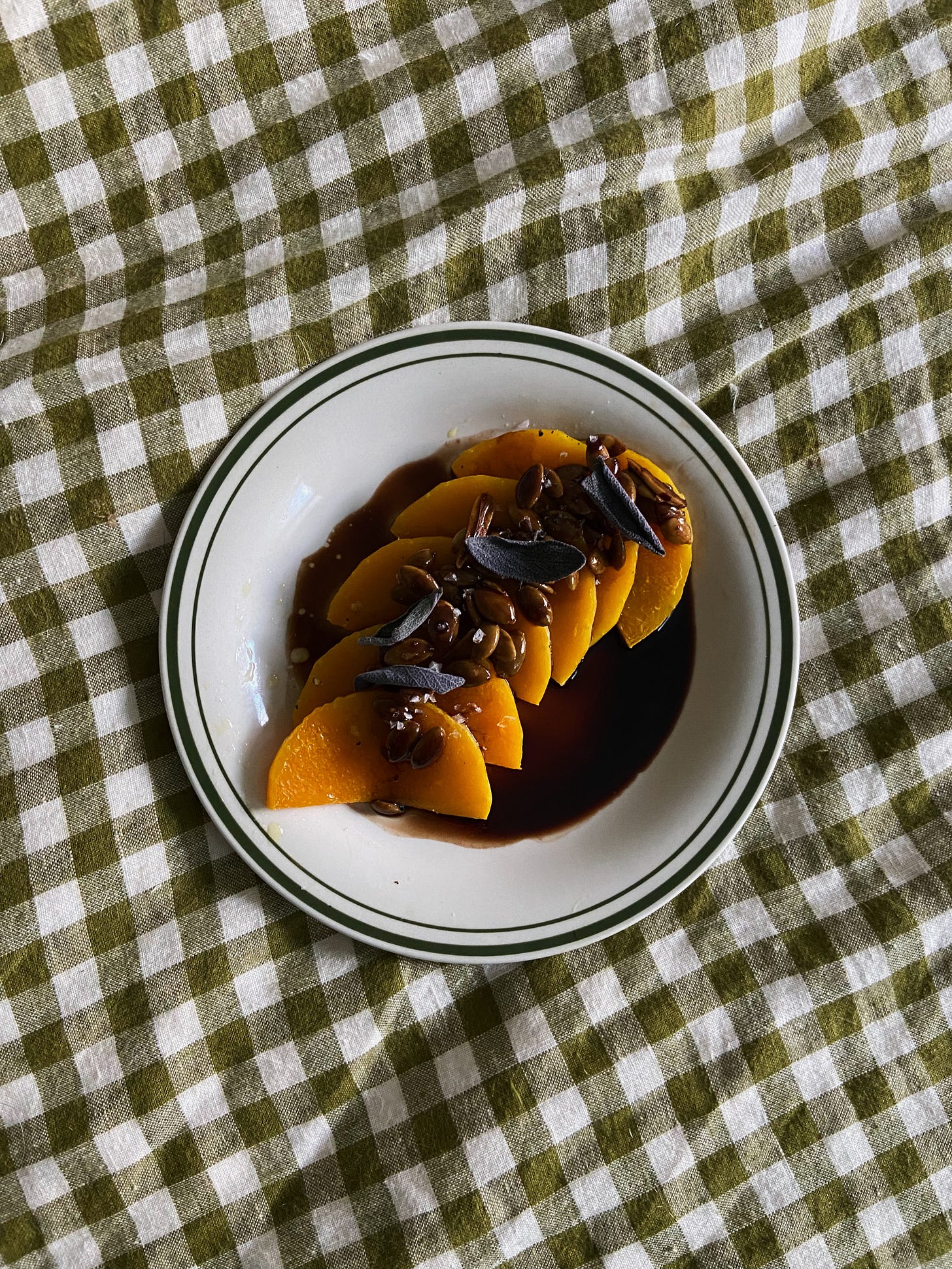I don’t really want to write a whole newsletter about Thanksgiving. For one thing, the true history of the holiday represents the disenfranchisement of indigenous people far more than any fabled treaty or season of cooperation. And, even in the contemporary sense, many of us are nauseated by the thought of sitting around a table with distant family who won’t stop talking politics, eating overcooked turkey, and catching judgmental glances when you refill your wine glass one too many times. And of course, the dreaded turn around the table, where each guest is prompted to say what they’re thankful for, and the performative blathering that follows. Why not just skip the holiday altogether?
Well, the issue is, I’m addicted to gratitude. Which is to say, I think there is no practice more essential to ones continued happiness than to, on the daily, feel and express gratitude for all the joys life has bestowed upon you. So of course, I have a soft spot for any holiday that basically requires you to do so. But, as I said, so often the gratitude expressed at Thanksgiving feels inauthentic, a minor obstacle standing between diners and their pumpkin pie. How can we approach Thanksgiving in a way that truly does allow us to embody a spirit of gratitude, and what does a holiday shaped by this guiding principle look like?
In her book Braiding Sweetgrass, indigenous botanist and author Robin Wall Kimmerer shares her experience with a different, more authentic type of gratitude, and the power it can hold- “In a consumer society, contentment is a radical proposition. Recognizing abundance rather than scarcity undermines an economy that thrives by creating unmet desires. Gratitude cultivates an ethic of fullness, but the economy needs emptiness.”. The gratitude she is referencing is being communicated in the Thanksgiving Address, a pledge that the Huadenosaunee people speak at all their gatherings, which Kimmerer was able to experience firsthand. I will link a translation of the pledge below, and I encourage you to read it in full, but the general idea behind the speech is to thank, one by one, the forces that sustain the lives of Huadenosaunee people, from trees and fish to the wind and stars.
One thing that stands out to me about the Thanksgiving Address is that it gives thanks for elements that are available to, and benefit everyone. This is not a thankfulness reserved only for things that the individual has found themselves lucky enough to posses, it is instead an expression of gratitude for that which is given freely and abundantly. Often our gratitude is defined by exclusivity, we are thankful to have things that might be taken from us, or are impermanent in nature. In fact, it is often only their scarcity that reminds us to appreciate them. But to the Huadenosaunee people, the most gratitude belongs to that which is perceived as permanent or eternal, such as the wind or the sun. This is, as Kimmerer explains, the antithesis of an economic system in which prosperity is measured by the amount of temporal objects one can accumulate.
This year, when sitting around the table, I urge you to remember the lessons of the Thanksgiving Address. What have you failed to express gratitude for because you may perceive it to be limitless and unchanging? In a world where many of the natural forces celebrated in the Address are indeed under threat, how can gratitude be used as a tool to defend and honor them? What does an “ethic of fullness” mean to you, and how can you use gratitude, rather than consumption, to combat emptiness? And most importantly, on a holiday commemorating the exploitation of Native people, and in a country built on violence against them, how can we center indigenous voices and ideals in a way that brings us closer to true cooperation, peace, and thanksgiving?
Produce Notes
Sweet Potato - Not only are sweet potatoes a star on any Thanksgiving table (do you prefer your casserole with marshmallows or pecans on top?), we just so happen to live in a state that produces up to 60% of the nations supply. I know it can be tempting to opt for the precooked, canned version lining grocery store shelves, but you would be shocked at the difference in quality you get when making candied yams from scratch. Although I should note that sweet potatoes and yams are NOT the same thing. Look for small to medium sized potatoes with even colored, unblemished skin. Store in a cool dry place.
Brussel Sprouts- Brussel sprouts are surprisingly tolerant to cold weather, and can even survive minor frosts. I’ve heard brussel sprouts harvested after a frost taste sweeter, but I’ve never had a chance to test that theory myself. If you can buy them on the stalk, I’d go for that, but regardless make sure the buds are small and bright green, with firm, densely packed leaves.
Sweet Potato Caesar
Similar to last month’s Oysters with Leche De Tigre, this recipe is really just an attempt at recreating a dish I love but can’t access easily. In this case it’s from Salita Pizza in Wilmington, NC. While a bit closer to home, the menu item was seasonal and they haven’t brought it back for this fall, so this is the only way to really get my fix. As with many of my recipes calling for anchovies, I urge you to use the highest quality ones you can find here. It will not only make the dish less fishy, but more flavorful overall.
2 large sweet potatoes
1 tbsp. olive oil
1 2oz. can anchovy filets
1/4 cup panko bread crumbs
4 tbsp. flat leaf parsley, finely chopped
1 1/2 tbsp. capers, finely chopped
1 small garlic clove, grated
Zest of 1/2 a lemon
1 tbsp. butter, divided
2 tbsp. freshly grated parmesan
Salt and pepper, to taste
Preheat oven to 425. Drizzle sweet potatoes in olive oil and wrap in tinfoil. Roast for 1 hour, until easily pierced and insides are very tender. Set aside to cool.
Drain the oil from the anchovies into a small skillet over medium heat. Add breadcrumbs and toast, stirring frequently, until golden and fragrant. Remove from heat and set aside
In a small bowl, combine parsley, capers, garlic, and lemon zest. Season with salt and pepper. Set gremolata aside.
Once potatoes are cool enough to handle, cut down the middle and open them up slightly, making sure not to cut all the way through. Spread 1/2 tbsp. butter on each potato, and evenly divide the parsley gremolata between the two. Next add the anchovy breadcrumbs, then sprinkle on parmesan. Top each potato with additional anchovies.
Brussel Sprout and White Bean Salad with Hot Honey Vinaigrette
As much as I love Thanksgiving food, I must admit most of it falls into the categories of “soft” and “beige”, and while those are both great in moderation I think finding ways to add color and texture to your plate can elevate the entire meal. Enter this salad which is full of flavor, and fiber which…might be useful after all those mashed potatoes. I have yet to find a local farm stand that sells pre-shaved Brussel sprouts, so go ahead and break out the mandolin for this one. On the bright side, I find hand shaved ones to be a lot crunchier in texture than the ones in bags at the store. I like to wait and make the vinaigrette/dress the salad till right before I’m about to serve, that way the whole dish is slightly warmed by the honey mixture.
3 cups shaved Brussel sprouts
1 small shallot, thinly sliced
1/4 cup pepitas
1 can cannellini beans, drained and rinsed
3 tbsp. pomegranate seeds
3 tbsp. honey
1/2 tbsp. red pepper flakes
1 tsp. Dijon mustard
Juice of 1/2 a lemon
1 garlic clove, grated
2 tbsp. olive oil
Salt and pepper, to taste
In a small saucepan over medium heat, combine honey and red pepper flakes. Allow to heat through, stirring frequently, until honey is runny and infused with the flavor of the red pepper, about 5 minutes. Remove from heat and pour honey mixture into a heat proof bowl or measuring cup.
Add mustard, lemon, and garlic to warm honey mixture and stir till combined. Then, slowly stream in the oil while whisking continuously, until dressing is well emulsified. Add salt and pepper to taste.
Combine brussels, shallot, pepitas, and beans in a large bowl. Add in the dressing and toss to combine. Serve topped with pomegranate seeds and additional pepitas.
Butternut Squash with Seedy Agrodolce
Agrodolce is Italian for “sweet and sour”, a combination of honey and vinegar that pairs perfectly with the earthy sweetness of the squash. We’re keeping the flavoring of the squash really simple so the sauce can shine through. Keeping with our theme of adding texture to our plate, I love the crunch you get from the seeds. Use any variety you have on hand, I think pepitas or dehulled sunflower seeds work the best. This is a relatively quick, simple to make dish, that tastes like it took a lot more time and effort. Remember not to overcook the agrodolce or it will become too thick and sticky to pour over the squash. If you don’t have butternut on hand, the sauce also taste delicious on sweet potatoes.
1 medium butternut squash, halved and deseeded
2 tsp. salt, plus more to taste
1 tsp. freshly cracked black pepper
1/4 cup balsamic vinegar
3 tbsp. honey
1 large clove of garlic, minced
2 tsp. red pepper flakes
1/4 cup pepitas, sunflower seeds, flax seeds, or some combination
Preheat oven to 400. Peel the squash and slice into half moons about 1/4 inch thick. Arrange slices on a foil lined baking sheet and drizzle with olive oil, salt and pepper. Roast for X minutes until tender
Meanwhile, prepare the agrodolce. Combine vinegar, honey, garlic, and red pepper flakes in a small pot over medium heat. Cook, stirring, until mixture begins to thicken and takes on a syrupy consistency, about 6 to 7 minutes. Add seeds and stir until well coated. Remove from heat and add salt to taste
Drizzle agrodolce over roasted squash and serve immediately.






